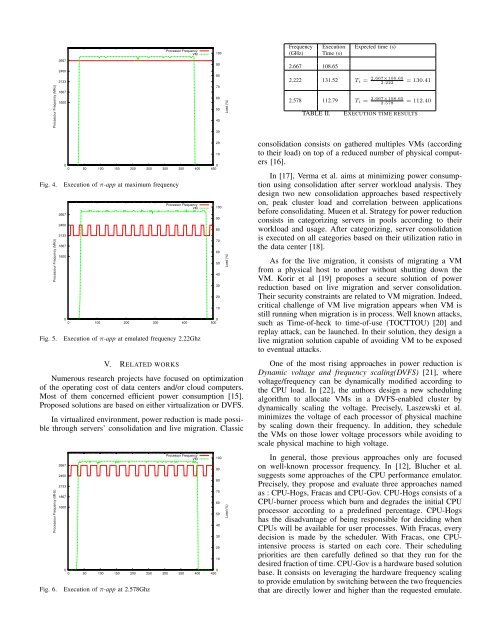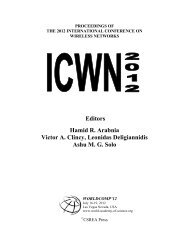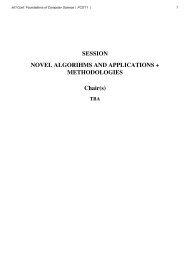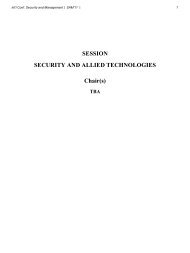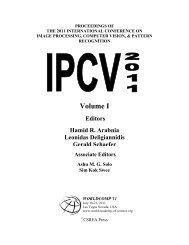Virtual processor frequency emulation - World-comp.org
Virtual processor frequency emulation - World-comp.org
Virtual processor frequency emulation - World-comp.org
You also want an ePaper? Increase the reach of your titles
YUMPU automatically turns print PDFs into web optimized ePapers that Google loves.
Processor Frequency<br />
VM<br />
100<br />
Frequency Execution Expected time (s)<br />
(GHz) Time (s)<br />
Processour Frequency (MHz)<br />
2667<br />
2400<br />
2133<br />
1867<br />
1600<br />
90<br />
80<br />
70<br />
60<br />
50<br />
40<br />
Load (%)<br />
2.667 108.65<br />
2.222 131.52 T i = 2.667×108.65<br />
2.222 = 130.41<br />
2.578 112.79 T i = 2.667×108.65<br />
2.578 = 112.40<br />
TABLE II.<br />
EXECUTION TIME RESULTS<br />
30<br />
Fig. 4.<br />
Processour Frequency (MHz)<br />
Fig. 5.<br />
10<br />
0<br />
0 50 100 150 200 250 300 350 400 450 0<br />
2667<br />
2400<br />
2133<br />
1867<br />
1600<br />
Execution of π-app at maximum <strong>frequency</strong><br />
0<br />
Processor Frequency<br />
VM<br />
0<br />
0 100 200 300 400 500<br />
Execution of π-app at emulated <strong>frequency</strong> 2.22Ghz<br />
V. RELATED WORKS<br />
Numerous research projects have focused on optimization<br />
of the operating cost of data centers and/or cloud <strong>comp</strong>uters.<br />
Most of them concerned efficient power consumption [15].<br />
Proposed solutions are based on either virtualization or DVFS.<br />
In virtualized environment, power reduction is made possible<br />
through servers’ consolidation and live migration. Classic<br />
Processour Frequency (MHz)<br />
Fig. 6.<br />
2667<br />
2400<br />
2133<br />
1867<br />
1600<br />
0<br />
0<br />
0 50 100 150 200 250 300 350 400 450<br />
Execution of π-app at 2.578Ghz<br />
Processor Frequency<br />
VM<br />
20<br />
100<br />
90<br />
80<br />
70<br />
60<br />
50<br />
40<br />
30<br />
20<br />
10<br />
100<br />
90<br />
80<br />
70<br />
60<br />
50<br />
40<br />
30<br />
20<br />
10<br />
Load (%)<br />
Load (%)<br />
consolidation consists on gathered multiples VMs (according<br />
to their load) on top of a reduced number of physical <strong>comp</strong>uters<br />
[16].<br />
In [17], Verma et al. aims at minimizing power consumption<br />
using consolidation after server workload analysis. They<br />
design two new consolidation approaches based respectively<br />
on, peak cluster load and correlation between applications<br />
before consolidating. Mueen et al. Strategy for power reduction<br />
consists in categorizing servers in pools according to their<br />
workload and usage. After categorizing, server consolidation<br />
is executed on all categories based on their utilization ratio in<br />
the data center [18].<br />
As for the live migration, it consists of migrating a VM<br />
from a physical host to another without shutting down the<br />
VM. Korir et al [19] proposes a secure solution of power<br />
reduction based on live migration and server consolidation.<br />
Their security constraints are related to VM migration. Indeed,<br />
critical challenge of VM live migration appears when VM is<br />
still running when migration is in process. Well known attacks,<br />
such as Time-of-heck to time-of-use (TOCTTOU) [20] and<br />
replay attack, can be launched. In their solution, they design a<br />
live migration solution capable of avoiding VM to be exposed<br />
to eventual attacks.<br />
One of the most rising approaches in power reduction is<br />
Dynamic voltage and <strong>frequency</strong> scaling(DVFS) [21], where<br />
voltage/<strong>frequency</strong> can be dynamically modified according to<br />
the CPU load. In [22], the authors design a new scheduling<br />
algorithm to allocate VMs in a DVFS-enabled cluster by<br />
dynamically scaling the voltage. Precisely, Laszewski et al.<br />
minimizes the voltage of each <strong>processor</strong> of physical machine<br />
by scaling down their <strong>frequency</strong>. In addition, they schedule<br />
the VMs on those lower voltage <strong>processor</strong>s while avoiding to<br />
scale physical machine to high voltage.<br />
In general, those previous approaches only are focused<br />
on well-known <strong>processor</strong> <strong>frequency</strong>. In [12], Blucher et al.<br />
suggests some approaches of the CPU performance emulator.<br />
Precisely, they propose and evaluate three approaches named<br />
as : CPU-Hogs, Fracas and CPU-Gov. CPU-Hogs consists of a<br />
CPU-burner process which burn and degrades the initial CPU<br />
<strong>processor</strong> according to a predefined percentage. CPU-Hogs<br />
has the disadvantage of being responsible for deciding when<br />
CPUs will be available for user processes. With Fracas, every<br />
decision is made by the scheduler. With Fracas, one CPUintensive<br />
process is started on each core. Their scheduling<br />
priorities are then carefully defined so that they run for the<br />
desired fraction of time. CPU-Gov is a hardware based solution<br />
base. It consists on leveraging the hardware <strong>frequency</strong> scaling<br />
to provide <strong>emulation</strong> by switching between the two frequencies<br />
that are directly lower and higher than the requested emulate.


